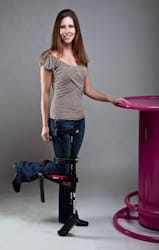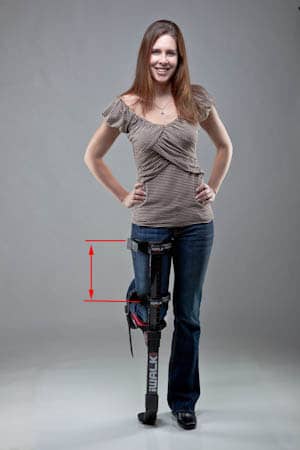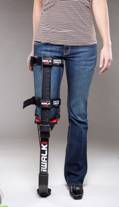Discontinued Model Instructions
Tailor the fit of your iWALKFree
Now we will cover how to tailor the fit of your iWALKFree. Adjustments are quick and easy and require no tools.
Wearing for the first time
Your safety is our first concern, so before using your
iWALKFree, please do the following:
- Read all instructions before starting the fitting process.
- Make sure that you are completely familiar with the various adjustment. Before wearing the iWALKFree, practice adjusting the knee platform height, adjusting and removing the thigh straps and setting the height of the thigh straps. Once you are familiar with them, you can try on your iWALKFree for the first time.
- Until you are proficient at wearing and using your iWALKFree, support yourself using a handrail, parallel bars or similar. Good household substitutes include the back of a sofa, a sturdy table or chair back, a guard rail or any other stable, waist high or higher device that can support your weight.
- IMPORTANT – Keep as much weight as possible on your uninjured leg when putting on the iWALKFree. try to put as little weight as possible on the iWALKFree until all the straps are on and adjusted.
As a reminder, before trying the iWALKFree for the first time, make sure that the device is right for you.

Set the Knee platform height
Sit in a chair with your knee bent at 90 degrees. Using your uninjured leg with shoe on, measure the distance from the ground (just behind your heel) to the bottom of your thigh (back of your knee – where your thigh meets your calf ). This measurement will be the initial height of the iWALKFree Knee platform (Figure 1-1). Note – you might fine tune the height after your first few times walking on the iWALKFree.

After you have completed your adjustment, make sure that the locking pin is securely engaged in the holes in the back of the beam and that the cam latch is closed. This will be the starting point for the Knee platform height adjustment.
Strapping iWALKFREE to your leg
In the following set of instructions you will be strapping the iWALKFree to your injured leg and adjusting the two thigh straps and the platform strap. Before proceeding, remember to support yourself by keeping as much of your weight as possible on your uninjured leg and using a table, sofa, etc. for balance.
Platform (calf) Strap
Remove the three adjustment straps from their buckles (platform strap and two thigh straps). Fig 2.1

Fig 2-1 Knee placed against the beam, platform strap assembly positioned as far back as possible
Slide the platform strap and buckle as far back as possible on the knee platform. With most of you weight being supported by your uninjured leg (this is important!), place the shin of your injured leg onto the knee platform pad, with your knee as far forward (toward the beam) as possible. Slip the adjustment strap into the buckle and snug the strap around your calf. If wearing a cast, you might need to put the strap over your cast, or you can slide the strap and buckle forward on the kKnee platform until the strap assembly is clear of your cast. Fig 2.2

Fig 2.2 Snug the strap around your calf.
Strap pad positioning
Make sure that the foam padding on the strap is centered on your calf (Fig 2.3.1-3). It’s essential that the foam pad does not interfere with the buckle. If the pad touches the buckle, you will not be able to fully tighten the strap and stability will be significantly compromised.. If the padding is not centered or touches the buckle, remove the crutch and slide the foam to the correct postion. If you have difficulty in moving the foam, see our Tips and Tricks section.
This also applies to the upper and lower thigh straps.



Lower thigh strap
The lower thigh strap serves two purposes A) It holds your lower thigh firmly against the beam B) It holds the front of your calf firmly against the knee platform and prevents your knee from lifting). To correctly fit the lower thigh strap:
- Position the lower (soft) thigh strap assembly so that it is just above your knee. Fig 3.1
- Insert the strap into the buckle and snug the strap, but do not fully tighten yet.
- Open the cam latch (at the front of the thigh saddle) and slide the entire thigh strap assembly as low as you can. Close the cam latch.
- Fully tighten the adjustment strap around your lower thigh.
- Check to make sure that the adjustment strap padding is centered on your thigh and is not touching the buckle (see Figure 2.3.1-3). If you need to change the position, remove the adjustment strap from the buckle and slide the foam padding to the correct position. For people with smaller legs, it may be necessary to trim the padding so that it does not contact the buckle and inhibit the strap from being fully tightened. If you have difficulty in moving the foam, see our Tips and Tricks section. Reinstall the strap through the buckle and tighten as in step 3 and 4 above.

Upper thigh strap
- Position the upper (hard) thigh strap assembly so that it is near the top of your leg (at the crotch). Fig. 4.1
- Insert the strap into the buckle and snug the strap.
- Open thecam latch (at the front of the thigh saddle) and slide the entire thigh strap assembly as high as you can (into the crotch area). Close the cam latch.
- Re-tighten the adjustment strap around your upper thigh. If the strap is uncomfortable in your groin area, you can lower it slightly. Fig 4.2
- Check to make sure that the adjustment strap padding is centered on your thigh and is not touching the buckle (see Figure 2.3.1-3). If you need to change the position, remove the adjustment strap from the buckle and slide the foam padding to the correct position. For people with smaller legs, it may be necessary to trim the padding so that it does not contact the buckle and inhibit the strap from being fully tightened. If you have difficulty in moving the foam, see our Tips and Tricks section. Reinstall the strap through the buckle and tighten.







Final tightening
Do a final tightening of all three straps. Get them as snug as you can without discomfort. Tip – hold the buckle against your leg with one hand while you pull firmly on the strap with the other.



Fig 5.1 All three straps tightened and in the correct position
Testing 1-2-3
Now that you’ve successfully strapped the iWALKFree to your leg, we can do a quick test to see if you’ve properly adjusted the knee platform height.
While standing with most of your weight on your uninjured leg, you should be able to swing the iWALKFree front to back without the rubber tread (foot) hitting the ground. Note that it should come very close to the ground without actually making contact. Figures 6.1 and 6.2 below show correct and incorrect knee platform height. Remember to use a handrail or similar for stability until you get used to the device.


Fig 6.1 Knee platform too high – foot tread hits ground during leg swing



Fig 6.2 Correct knee platform height – leg can freely swing though, tread just above ground at mid stride
You’re done!
Congratulations! You’ve completed the initial fitting of your iWALKFree. For more information, click here to see video instructions.
You can now proceed to the How to Use section, where you be instructed on how to walk on your iWALKFree.

